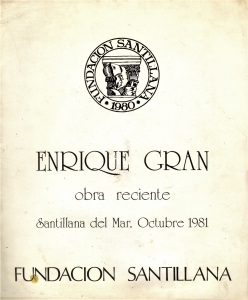Enrique Gran-Antonio Bonet Correa (1981)

The exhibitions held at the Fundación Santillana, Cantabria and the Museo de Bellas Artes in Santander
THE DEEP HEARTBEAT OF NATURE
IN THE PAINTING OF ENRIQUE GRAN
Text for the exhibition catalogues by Enrique Gran.
Santillana Foundation, Cantabria.
October 1981.
Museum of Fine Arts, Santander.
1981
Steppes and deserts, Niagara or Orinoco Falls, structure and life and death, the physiognomy of plants and animals or the life force of any living being leave us absorbed. Faced with the spectacle of nature, man has no greater response than admiration or the attempt to establish scientific knowledge.
Only the artist, with his ability to transpose emotions, can offer us the painting that takes us to a state of mind that exceeds, in the small dimensions of the canvas or the board, however large they may be, the emotion produced in us by what the philosophers of the Enlightenment described as sublime. And just as Jules Verne did not need to travel to the highest places to describe them, the painter – in this case Henry Gran – has not been forced to travel in search of the motive either. His inner world is enough.
Any geographical incident, any observation of life, the perception of any act before his eyes acquires gigantic dimensions, becomes a torrent of images overflowing with pictorial strength and vigour.
Enrique Gran’s tight and restless painting constitutes in itself a spectacle so fertile in emotions that it is only comparable to the whirlwinds of the rivers, the waves of the ocean or the night of a jungle with the infinity of phosphorescent insects and the tangle of climbing plants that impede the passage.
His dreamlike vision, which links him to the pre-romantic and especially, within Spain, to Goya, is only exhausted in his self-absorption of the phenomenal. His art, which is difficult to classify within the modern currents of expression, as well as his own human personality, is endowed with a restlessness that does not cease. His work has echoes that resound in the large spaces of his “landscapes”, in which strange, piled up, sombre bodies are condensed, which, driven by stormy forces, are lost in infinite distances.
Their turbulence, however, also knows calm, serenity and placidity. In many of Enrique Gran’s paintings, the horizons are clear and the surfaces are smooth and of very fine tones, with a brilliant polychromy. A new world then emerges from his paintings. The cosmos becomes relevant again. The dichotomy of his painting, which is both brilliant and soft, opens up a renewed admiration for the strength of mind that man has when dreams and reality converge in his spirit and the pulse of nature’s deepest heartbeat can be felt, whether it is fast or slow.
Antonio Bonet Correa
